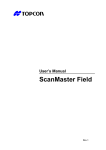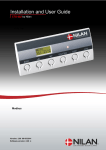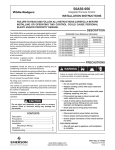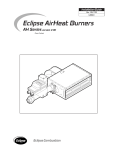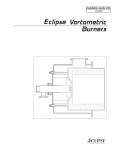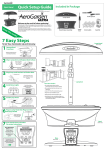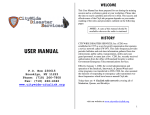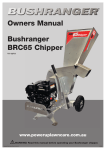Download Eclipse Combustion DAH User's Manual
Transcript
Info 140 11/4/03 ECLIPSE AIR HEAT BURNERS Series “AH”, “DAH”, “TAH” & “CAH” U.S. Reissue Pat. No. 26,244 Canadian Pat. No. 743,782 AH, Front View Data 140-1 AH, Back View Data 140-1 TAH Data 140-3 CAH Data 140-4 DAH, Blower Down Data 140-2 WARNING The burners covered in this Guide are designed to mix fuel with air and burn the resulting mixture. All fuel burning devices are capable of producing explosions and fires when improperly applied, installed, adjusted, controlled, or maintained. This Guide will provide information for using these burners for their limited design purpose. Do not deviate from any in- structions or application limits in this Guide without written advice from the Eclipse Combustion Division in Rockford, Illinois. Read this entire Guide before attempting to light burners. If you do not understand any part of the information in this Guide, contact your local Eclipse representative or Eclipse Combustion before proceeding further. Important Notices About Safe Burner Operation Storage Store the burner inside. Exposure to the elements can damage the burner. Qualifications Adjustment, maintenance, and troubleshooting of the mechanical parts of this unit should be done by people with good mechanical aptitude and experience with combustion equipment. Replacement Parts Order replacement parts from Eclipse only. Any customer-supplied valves or switches should carry UL, FM, CSA, and/or CGA approval where applicable. Operator Training The best safety precaution is an alert and competent operator. Thoroughly instruct new operators so they demonstrate an adequate understanding of the equipment and its operation. Regular retraining must be scheduled to maintain a high degree of proficiency. The operator must have easy access to this Information Guide at all times. 1.0 Burner Operating Parameters & Requirements Applications Eclipse Air Heat Burners are line type burners ideal for generating large volumes of clean, hot air. Applications include ovens, dryers, fume incinerators, and similar industrial equipment. The “AH” models feature an integral combustion air blower mounted on the back of the burner’s steel case. By supplying the correct air volume and pressure to the burner, the blower allows stable operation over a wide range of duct velocities without installing a profile plate around the burner. Capacities & Supply Pressures See Figure 2. Burner Environment Weather Protection: Protect burners from the weather. Combustion Air: Must be free of contaminants. Eclipse strongly recommends use of a combustion air filter to remove airborne particles. If corrosive fumes or materials are present in the air, supply the blower with fresh, clean air from an uncontaminated area of the plant. Room Openings: If the burner is mounted on the side of the duct, provide at least one square inch of opening to the outdoors for every 4000 Btu/hr (1.2 kW) of burner firing rate. This will admit fresh combustion air. Access: Provide access to the burner for inspection and maintenance. Figure 1–Ignition, Flame Monitoring, and Pilot Components Scanner Adaptor 109000 For Sizes through 400 AH Flame Rod #13093-3 Mounting Bracket Spark Plug #13047 Pilot Cock #12659 Pilot Regulator #15027 Pilot Gas Inlet 1/4" N.P.T. 2 Mount In Place of Peepsight 3/4"N.P.T. Scanner Connection 1/2" N.P.T. Scanner Adaptor 109559 For Sizes 440 through 800 AH Main Gas Inlet 2" N.P.T. Peepsight #10509 3/4" N.P.T. Mount In Place of Flame Rod 1/4"N.P.T. Eclipse AirHeat v1.0 - Installation Guide No. 140, 11/4/03 Scanner Connection 1/2" N.P.T. Specifications Input: 1,000,000 Btu/hr. per lineal foot (962 kW/m). Fuels: Natural gas or 100% propane vapor. Call Eclipse for information on using other fuels. Gas Turndown: 40:1 Pilot Input: Approximately 25,000 Btu/hr. (7.3 kW) Gas Inlet Pressure: 800,000 Btu/hr/ft. (769 kW/m): Nat. Gas: Propane: 2.2" w.c. 0.9" w.c. 5.5 mbar 2.2 mbar 1,000,000 Btu/hr/ft. (962 kW/m): Nat. Gas: Propane: 3.5" w.c. 1.3" w.c. 8.7 mbar 3.2 mbar Gas pressure shown is a differential measured between the gas inlet and a tap on the duct wall 10" to 20" (254 to 508 mm) downstream of the burner. Ambient Temp. Limits*: – 40° to +104° F Downstream Temp. Limits: 1500° F – 40° to +40° C 815° C Flame Length**: 800,000 Btu/hr. (769 kW/m): 1,000,000 Btu/hr. (962 kW/m): 28" 46" 0.71 m 1.17 m Piloting: Integral spark-ignited pilot; ignition plug included. Flame Monitoring: Flame rod supplied. UV scanner adaptors are available. For UV scanners, Eclipse recommends a flame monitoring system that terminates the ignition spark and proves the pilot flame without spark prior to opening the main gas valves. CGA requires two flame rods on burners over 36" long (914 mm). Use a flame monitoring endplate (see Data 140-6) to mount a second flame rod on the end opposite the gas inlet. Motor: Standard: 230/460/3/60 TEFC. Other motors can be supplied. Materials: All portions of the burner exposed to flame are cast iron or #321 stainless steel. Emissions: Emissions performance depends not only on the burner, but also other factors such as chamber temperature, chamber design, and heat loading. For estimates of emissions performance in your application, call Eclipse. Packaging Options: Available with complete valve trains and control systems. AH burners and systems can be supplied mounted on duct sections as specified by the customer. Call Eclipse for information on custom packaged systems. Models: Model Description Data Sheet AH DAH TAH CAH Line-shape, blower mounted on rear Line-shape, blower mounted on bottom “I”-shape, blower mounted on rear Cross-shape, blower mounted on rear Data 140-1 Data 140-2 Data 140-3 Data 140-4 Related Information: Blower and motor specifications Data 140-5 * Based on blower motor limitations. ** Based on parallel air flow. If mounted in a cross flow, then flame will be shorter. CAUTION: It is dangerous to use any fuel burning equipment unless it is equipped with suitable flame sensing devices and automatic fuel shut-off valves. Eclipse can supply such equipment or information on alternate sources. Eclipse AirHeat v1.0 - Installation Guide No. 140, 11/4/03 3 2.0 Control System Requirements Turndown Method Input is normally controlled by a motorized butterfly valve in the gas line to the burner. Regulator Loading Lines Connect the top diaphragm chambers of the main gas and pilot gas regulators to the duct approximately 10" downstream of the burner. This will allow the regulators to maintain a constant supply pressure to the burner regardless of varying pressures in the duct. Piloting Pilot gas flow is adjusted as shown in Figure 6. Ignition Ignition voltage should be 6000 VAC. Check Valve See Figure 3. At high fire, the gas pressure at the burner inlet is higher than the air pressure, and the check valve is closed. At low fire, gas pressure falls below the air pressure, and the check valve opens, permitting a small amount of air to mix with the gas. This premix at low fire stabilizes the flame and helps distribute the flame evenly down the length of the burner. w Warning Pressure Switch Connection Do not install any valve or controlling device in the gas line between the burner and the check valve tee, Figure 3. Because this section of the gas line carries a partial pemix at low fire, it is possible under unusual conditions for the flame to travel back through the pipe to the tee. Devices installed in this section may be damaged and may melt, releasing gas to the atmosphere and causing fires or explosions. See Figure 4 for typical connection of combustion air and circulating fan limit switches. Limit Controls &Safety Equipment Limit controls and safety equipment should comply with current NFPA Standards* 86 and 86C, and all applicable local codes and/or standards. *Available from: National Fire Protection Association Batterymarch Park Quincy, MA 02269 Figure 3–Check Valve Operation American National Standard Inst. 1430 Broadway New York, New York 10018 Figure 4—Pressure Switch Location Blower Pressure Switch WARNING! Do Not Install Any Valves Here! See Section 2.0 P Tube at Blower Inlet Tee Lo Hi Burner Air Tap See Figure 7 Process Air Gas Inlet Manifold Check Valve Opens When Gas Inlet Pressure Is at Low Fire 4 P Tube Points Upstream Hi Lo Circulating Air Pressure Switch Eclipse AirHeat v1.0 - Installation Guide No. 140, 11/4/03 Tube Points Downstream Figure 5–Mounting & Duct Lengths In-Duct Sealed Slot-Fired Duct Press: +0.2" to –0.5" w.c. +0.5 to –1.2 mbar Duct Press: 0" to –0.5" w.c. 0 to –1.2 mbar Min./Max. Velocity: 500 to 6000 fpm 2.54 to 30.48 m/s Optimum Velocity: 1000 to 4000 fpm 5.08 to 20.32 m/s Min./Max. Velocity: 500 to 1200 fpm 2.54 to 6.10 m/s Min./Max. Velocity: 500 to 1200 fpm 2.54 to 6.10 m/s • Provide at least 3" (76 mm) clearance between burner and top, bottom and sides of the duct. • Profile plates are not required for good burner operation, but uniform velocity must be maintained for full length of burner. If velocity is not uniform, profile plates can be used to correct this condition. Min./Max. Velocity: 500 to 1200 fpm 2.54 to 6.10 m/s Min./Max. Velocity: 500 to 1200 fpm 2.54 to 6.10 m/s Guidelines for All Mounting Arrangements • Center the burner in the duct. • Allow a minimum of 46" (1168 mm) from burner to nearest point of possible flame impingement at an input of 1,000,000 Btu/hr. (962 kW/m). Min./Max. Velocity: 500 to 6000 fpm 2.54 to 30.48 m/s • On burners longer than 36" (914 mm), use a hanger or a pedestal to support the blower and motor. Optimum Velocity: 1000 to 4000 fpm 5.08 to 20.32 m/s Duct Lengths Minimum Distance Before Transition Rectangular Ducts: One Height or Width, Whichever is Greater Round Ducts: One Diameter 7.5° Maximum Air Flow AH Burner Minimum Distance Before Possible Flame Impingement = 46" Eclipse AirHeat v1.0 - Installation Guide No. 140, 11/4/03 5 3.0 Duct Design and Burner Mounting Duct Design See Figure 5 for typical mounting arrangements and duct designs. Support The mounting flange or brackets supplied with an AH burner are capable of supporting the weight of the burner and blower. The AH burner case itself is designed to support the weight of the blower, so the blower does not require independent support. Valve Train Support Support valve trains independently of the burner. Gas Piping Use flexible nipples to allow for thermal expansion of the burner. Check Valve Piping Gas flow through the check valve must be horizontal. See Figure 3. Gas Piping Standards Gas piping must comply with American National Standard entitled “National Fuel Gas Code”* (NFPA No. 54 or ANSI Z223.1), or must be acceptable to the authority having jurisdiction. Wiring Standards Electrical wiring must comply with the National Electric Code*, (NFPA Std. 70 or ANSI-CI 1981), or must be acceptable to the authority having jurisdiction. *Available from: National Fire Protection Association Batterymarch Park Quincy, MA 02269 4.0 American National Standard Inst. 1430 Broadway New York, New York 10018 Start-Up And Adjustment Initial Settings Adjust the linkage of the gas control valve so that when heat is called for, the valve is 10° from fully open, and when cooling is required, the valve is approximately 5° from fully closed. Close all manual gas cocks. With the pilot cock handle in the closed position, remove the top screw and turn the adjusting screw five turns out from fully closed. See Figure 6. Start Blower Start the combustion air blower on the burner. Check the rotation to make sure it is correct. If not, have a qualified electrician rewire the blower for proper rotation. Start Circulating Fan Start the duct circulating fan. Figure 6–Pilot Cock Handle (Shown in Open Position) Figure 7–Pressure Measurement Top Screw Air Pressure Taps (2) Gas Pressure Tap Duct Tap 10" to 20" Downstream of Burner Adjusting Screw (Clockwise for less pilot gas, Counterclockwise for more pilot gas) 6 Eclipse AirHeat v1.0 - Installation Guide No. 140, 11/4/03 4.0 Start-Up And Adjustment (cont’d.) Set Air Pressure Drop Measure the air pressure drop across the burner as shown in Figure 7. Turn the disc on the blower air inlet until the air pressure drop is between 0.4" w.c. minimum and 1.0" w.c. maximum. For a given input, lower air pressure drops will produce a longer flame, and higher drops will produce a shorter flame. Large Burners Only: Some models, such as the 640, 680, and 720 TAH burners, contain a butterfly valve in the check valve line as shown in Figure 8. On these models, after setting the air flow as described in the previous paragraph, measure the air pressure drop between the gas pressure tap and duct as shown in Figure 7. Gas flow must be off. Adjust the butterfly valve to produce an air pressure drop of 0.2" w.c. Start Spark Set Pilot Flow Energize the ignition spark. Do not touch the ignition rod, ignition wire, or transformer while the spark is energized, or you will get a shock. Open all pilot gas valves, including the handle of the pilot cock, Figure 6. The pilot should light. Figure 8–Butterfly in Check Valve Line Butterfly Valve On 640, 680 & 720 TAH Burners Check Valve Turn the pilot adjusting screw to produce a bushy blue flame that provides a flame monitoring signal strong enough to reliably open the gas shut-off valves. Set Gas Flow Measure the gas differential pressure as shown in Figure 7. With the gas control valve at low fire, open all main gas valves. The burner should light with a stable, blue low fire flame that extends evenly down the burner length. Drive the control valve to high fire and adjust the gas adjusting valve to produce a pressure drop that corresponds to the desired high fire rate, as shown in Fig. 1. When setting high fire, be sure the flame does not impinge on anything downstream of the burner. To shorten the flame length for a given gas input, increase the air pressure drop as described above. Check All Settings 5.0 Return the burner to low fire and check to be sure that the burner remains lit with a stable flame that extends down the burner length. Cycle the burner between low and high fire several times, checking pressure drops and flame lengths. Routine Maintenance Motor Lubrication Oil the blower motor according to the manufacturer’s instructions as printed on the motor label. Ignition Plug/Flame Rod Ignition plugs and flame rods wear out over long periods of normal burner operation. Eclipse recommends that the user keep at least one of each in stock at all times to prevent nuisance shutdowns. Eclipse AirHeat v1.0 - Installation Guide No. 140, 11/4/03 7 6.0 Trouble-Shooting Symptom 1. Burner does not start initially. Cause a) Air pressure switches not making. Check Remedy b) Faulty pressure switches. a) Check pressures in duct at location of switch connections. b) Check electrical portion of switch. a) Change pressure connections where a more positive pressure is present. 2. Burner kicks out shortly after start-up. a) Low gas pressure switch set too high. a) Check low pressure switch setting. a) Reset 3. Pilot will not ignite on initial light-off. a) Raw gas fed into pilot causing carbon hair on spark plug. a) Check spark plug for carbon hair; also check gap on plug (should be 3/64" - 3/32". a) Adjust pilot gas cock by first screwing needle closed, then with transformer powered, open needle slowly 1/4 turn at a time. 4. Flame failure when burner goes to high fire. a) Gas pressure to pilot regulator too high. a) Check pilot gas pressure to regulator (should be 1 PSIG maximum). b) Check tightness of bolts. a) Relocate pilot gas line or use second pilot regulator. b) Tighten bolts. c) Clean impulse line of any dirt particles and relocate duct connection to transmit maximum duct pressure. d) Clean check valve. b) Bolts which fasten pilot casting to burner are not tight enough. c) Pilot regulator not reacting fast enough to duct pressure changes. d) Check valve stuck open. e) Too much pilot gas. c) Check impulse line for possible dirt clogging; also check impulse line duct connection to determine if an effective pressure is being transmitted to regulator. e) Reduce pilot gas flow. 5. Flame failure when main burner returns from high to low fire. a) Gas pressure to pilot regulator. b) Under-gassing pilot. a) See Check 4a. a) See Remedy 4a. b) Check pilot regulator inlet and outlet gas pressures; also check pilot flame. c) See Check 4c. b) Open needle on pilot adjusting cock slowly 1/4 turn at a time. 6. Main flame too large at high fire. a) Gas pressure too high at burner inlet. a) Check gas pressures. b) Combustion air pressure too low. b) Check air pressure differential. c) Check valve stuck open. 7. Main flame not extending beyond face of burner at high fire. a) Air pressure differential too high. b) Burner not firing rated input. c) Burner gas holes plugged. 8. Main flame long and yellow. Info 140 11/4/03 a) Velocity past burner lower than 500 FPM. b) Check valve stuck open. c) See Remedy 4c. a) Screw out on main gas pressure regulator. Adjust linkage on gas control valve to hold valve less than full open when at high fire. b) Open air shutter on makeup air blower. c) Clean check valve. a) Check air pressure differential between combustion air manifold and main duct. b) Check gas pressure differential. c) Check gas holes for dirt or lint. a) Close air shutter on makeup air blower. b) Screw in on main gas pressure regulator to provide more gas. c) Clean gas holes with #42 MTD drill. Clean air holes with #27 MTD drill. a) Check velocities and rotation of main circulating fan. a) Open shutter on makeup air blower. b) Clean check valve.








